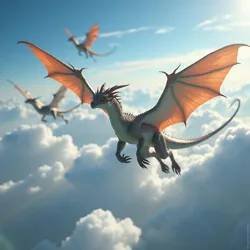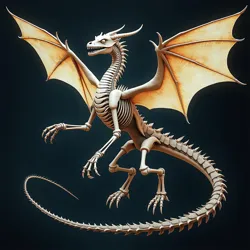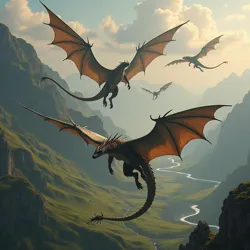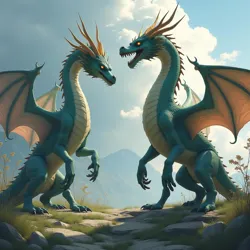Ventus Dragons

Ventus Dragons soaring in the upper atmosphere of Dracona, inhabiting the Ventus Expanse.
Ventus Expanse
up to 30 meters
aeroceptive crest
windways
regulate atmospheric systems
Ventus Dragons are the soaring masters of Dracona's upper atmosphere, inhabiting the turbulent aerial realms known as the Ventus Expanse. These majestic creatures represent the epitome of aerodynamic evolution, with bodies perfectly adapted for sustained flight and manipulation of air currents. Distinguished by their lightweight skeletal structure and expansive wingspans, Ventus Dragons play a crucial role in Dracona's atmospheric dynamics and weather patterns.
Physical Characteristics
Ventus Dragons possess several unique adaptations that enable their mastery of flight. Their bones are hollow yet reinforced with an intricate lattice structure, similar to those found in Earth's birds but evolved to support much larger bodies while maintaining minimal weight. Their wingspan-to-body ratio is the highest among all Draconian dragon species, with some specimens achieving wingspans of up to 30 meters while maintaining relatively slender bodies.
 Ventus Dragon skeleton structure, wingspan, and specialized wing membranes adapted for flight.
Ventus Dragon skeleton structure, wingspan, and specialized wing membranes adapted for flight.The wings of Ventus Dragons feature specialized membranes with microscopic structures that can detect and respond to minute changes in air pressure and temperature. These membranes contain a network of highly sensitive nerve endings that allow the dragons to "read" air currents with extraordinary precision. The leading edges of their wings are equipped with adjustable scales that can be manipulated to alter air flow and achieve optimal lift in varying atmospheric conditions.
Their scales are lightweight and aerodynamic, with a unique overlapping pattern that reduces drag while providing insulation against the extreme temperatures of high altitudes. The scales also possess remarkable properties of static electricity manipulation, allowing Ventus Dragons to sense and interact with atmospheric electrical fields. This ability plays a crucial role in their navigation during storms and their occasional generation of localized weather phenomena.
Sensory Adaptations
Ventus Dragons have developed highly sophisticated sensory systems specifically adapted for aerial life. Their eyes are protected by multiple transparent membranes that can adjust to different atmospheric pressures and maintain moisture at high altitudes. These membranes also filter harmful solar radiation, allowing the dragons to gaze directly at Solara when necessary for navigation.
The most remarkable sensory organ of Ventus Dragons is the aeroceptive crest, a specialized structure running along their head and neck. This crest contains thousands of microscopic sensors that can detect changes in air pressure, temperature, humidity, and electrical charge. The information gathered by the aeroceptive crest allows Ventus Dragons to predict weather patterns, locate thermal updrafts, and navigate through even the most turbulent conditions with grace.
Behavior and Social Structure
Unlike their more solitary cousins, Ventus Dragons exhibit complex social behaviors and often form large communal groups known as "windways." These social units can consist of anywhere from dozens to hundreds of individuals, though they frequently break into smaller hunting or patrol groups during daily activities. The windways are typically led by experienced elder dragons who possess intimate knowledge of air currents and weather patterns.
 Ventus Dragons forming large communal groups known as windways, led by elder dragons.
Ventus Dragons forming large communal groups known as windways, led by elder dragons.Flight Patterns and Territories
Ventus Dragons establish territorial boundaries not through physical landmarks but through consistent flight paths and air current manipulation. These territories, known as "wind domains," are three-dimensional spaces defined by regular patterns of air movement and atmospheric conditions. The dragons actively maintain these domains through regular patrols and the subtle manipulation of air currents using their wings and innate abilities.
The concept of territory among Ventus Dragons is more fluid than that of other dragon species, as the boundaries of wind domains can shift with seasonal changes in atmospheric patterns. This has led to the development of complex social protocols for negotiating territorial boundaries and sharing particularly favorable air currents during migration seasons.
Communication
Ventus Dragons have developed a sophisticated system of aerial communication that combines visual displays, vocalizations, and deliberate manipulation of air currents. Their primary mode of communication involves intricate flight patterns that can convey complex messages visible to other dragons from great distances. These aerial displays are often accompanied by harmonious vocalizations that can carry for kilometers through the thin upper atmosphere.
A particularly fascinating aspect of Ventus Dragon communication is their ability to create "whisper winds" - precisely controlled air currents that can carry messages to specific individuals or groups without being detected by others. This form of private communication plays a crucial role in maintaining social hierarchies and coordinating group activities.
Ecological Role
Ventus Dragons serve as key regulators of Dracona's atmospheric systems, their activities helping to maintain global weather patterns and climate stability. Through their daily movements and hunting activities, they influence air circulation patterns and help distribute heat and moisture throughout the planet's atmosphere.
 Ventus Dragons regulating Dracona's atmospheric systems and influencing weather patterns.
Ventus Dragons regulating Dracona's atmospheric systems and influencing weather patterns.Weather Influence
The collective activity of Ventus Dragon populations can significantly impact local and regional weather patterns. Large groups of dragons can create or dissipate cloud formations through their flight patterns and their ability to manipulate air temperature and humidity. During breeding seasons, massive gatherings of Ventus Dragons have been observed creating spectacular atmospheric phenomena known as "dragon storms," characterized by unique cloud formations and patterns of lightning that play a crucial role in their mating rituals.
Interaction with Other Species
While primarily adapted for life in the upper atmosphere, Ventus Dragons maintain important ecological relationships with other Draconian species. They serve as apex predators of the aerial ecosystem, controlling populations of flying creatures and maintaining balance in the food web. Their hunting activities also influence the distribution of airborne seeds and spores, contributing to plant dispersal across Dracona's various biomes.
Breeding and Development
The reproductive cycle of Ventus Dragons is intricately linked to atmospheric conditions and celestial events. Mating typically occurs during specific periods when atmospheric conditions are optimal for their elaborate courtship displays. These displays involve complex aerial acrobatics and the creation of visible patterns in the air through manipulation of water vapor and electrical charges.
Nesting Habits
Ventus Dragons construct their nests at extremely high altitudes, often incorporating both physical structures and maintained air currents. These "windnests" are architectural marvels that combine physical materials with carefully controlled air flows to create stable, protected environments for their eggs and young. The construction and maintenance of these nests require considerable skill and energy, as they must withstand the extreme conditions of the upper atmosphere while providing suitable conditions for egg incubation.
Growth and Maturation
Young Ventus Dragons, known as "windlings," face significant challenges in their early development. They must quickly develop the strength and skills necessary for sustained flight, as their survival depends entirely on their ability to navigate the demanding conditions of their aerial habitat. Adult dragons often create specialized training winds - carefully controlled air currents that help young dragons develop their flight abilities gradually and safely.
Cultural Significance
The Ventus Dragons have captured the imagination of the Explorers of the Obsidian Eye, who have documented their behavior through advanced atmospheric monitoring systems. The dragons' ability to manipulate weather patterns and their complex social structures have led to numerous scientific studies aimed at understanding their role in Dracona's global atmospheric regulation.
Their shed scales and feathers are particularly valued for their unique properties, including their ability to detect and respond to air currents. These materials have been studied for potential applications in atmospheric monitoring and weather prediction technologies. The Windborne Artifacts created from Ventus Dragon materials are considered highly precious among researchers and collectors throughout known space.